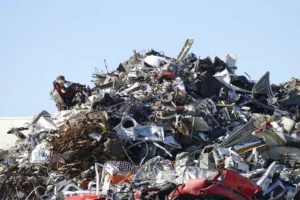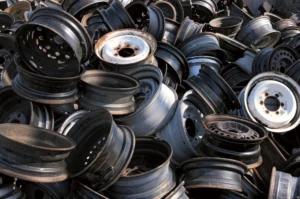If you’ve ever disposed of a junk car by selling it to an auto salvage recycling yard in Montcalm, MI, you’d have likely felt relieved. After all, having a junk car on your property detracts from the appearance of your home or business and can cause you unnecessary friction with neighbors and local code enforcement officials. You may have wondered what exactly happens to your junk car after selling it to a salvage company in Montcalm, MI.
Junk cars sold for scrap metal recycling are only beginning their journey when you sign them over to a salvage yard. There are many steps that must be completed before they can once again be rendered into recycled metal that is usable in many different industries. Keep reading to learn what happens to your junk car after you sell it for scrap.
Step 1: Removing the Car
The first step before the salvage process can begin is to remove the junk car from your property and transport it to a salvage facility where the next steps can begin. Usually, if the car is immobilized or has been sitting on your property for a long period, a flatbed tow truck may be required to move the vehicle. If the car will still move but has mechanical issues, a conventional tow truck may pick it up and tow it to the salvage facility.
Step 2: Draining Fluids
 The next thing that happens is the removal of all the fluids that may be left in the vehicle. Even if the junk car has been sitting unused for a long time, there will still be oil, transmission fluid, and brake fluid that must be removed before further steps are initiated. That’s because those fluids pose not only an environmental concern, but they can also be explosive under the right circumstances, which poses a significant danger to the scrappers.
The next thing that happens is the removal of all the fluids that may be left in the vehicle. Even if the junk car has been sitting unused for a long time, there will still be oil, transmission fluid, and brake fluid that must be removed before further steps are initiated. That’s because those fluids pose not only an environmental concern, but they can also be explosive under the right circumstances, which poses a significant danger to the scrappers.
Step 3: Parting It Out
Even if there’s a significant issue with your vehicle, there will still probably be useful parts that can be installed on working vehicles. Because of this, prized components that retain value as used auto parts may be removed from the junked vehicle before the scrapping process continues. Those parts are then sold at a discounted price to those who want to save money by purchasing used parts. Some auto salvage yards allow members of the public to inspect the junked cars and pick parts from them. Also, even those parts that aren’t functional have some value as cores, so they may be pulled and sold to parts rebuilders to generate additional income from the junked car.
Step 4: Plastic and Rubber Recycling
Some salvage yards will go to the extra step of removing all rubber and plastic components of the scrap vehicle and recycle those pieces independently. While the metal parts carry the most value, there are multiple applications for recycling or upcycling interior plastics, tires, and other non-metallic components.
Step 5: Aluminum Recycling
As vehicle manufacturers continue to strive for cars with greater fuel economy, materials that provide reduced weight are coveted. For this reason, there is plenty of lightweight aluminum found on today’s automobiles, and that aluminum can be infinitely recycled. Aluminum parts will be removed from scrap cars before the steel is processed in most cases.
Step 6: Steel Recycling
 The most common scrap metals found in vehicles are steel and iron. In fact, those materials represent more than 60 percent of the vehicle’s total weight. The steel parts of the car are flattened with a crusher, then ground into bits by a powerful shredder. Most of the steel and metal gets converted back into new car parts, but it can be used for almost any purpose.
The most common scrap metals found in vehicles are steel and iron. In fact, those materials represent more than 60 percent of the vehicle’s total weight. The steel parts of the car are flattened with a crusher, then ground into bits by a powerful shredder. Most of the steel and metal gets converted back into new car parts, but it can be used for almost any purpose.
The junk car you sell for scrap goes through a long process before being ready for use again, but it still uses less energy than beginning from scratch with newly mined metals. To learn more about the process of scrapping a junk car, contact Fair Salvage Company at (989) 386-7552.

